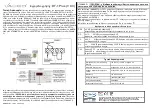
KPC-9612 Version 5.2 July 19, 1994
16
Introduction to Commands
Some Abbreviations
<Ctrl-x>:
This represents a single control character sent from your terminal program to the
KPC-9612. To send this character, press and hold the control key and type the sec-
ond key (x) while holding the control key down. If another letter follows this (i.e.
<Ctrl-C>T) do not continue to hold the control key down while pressing the other
letter. If your keyboard does not have a control key, consult your computer/terminal
manual to determine which key performs the control key function. If your terminal
does not have a key that performs this function, you will need to change the param-
eters in the KPC-9612 that define these special Ctrl key characters.
$
preceding a number denotes a hex number {base 16)
<CR>:
carriage return, $OD, decimal 13, <Ctrl-M>, ENTER key
<LF>:
line feed, $OA, decimal 10, <Ctrl-J> I/O: In put/Output
Entry
A command is entered to the KPC-9612 by typing the command name and its argument (setting or
value) in the Command Mode. The prompt for the Command Mode is
cmd:
The command name and the argument must be separated by a space, and the KPC-9612 takes ac-
tion when a carriage return <CR> is typed. All commands may be abbreviated to the shortest
string indicated by the CAPITAL letters in the command reference
You may examine the value of any parameter by typing the command name followed by a <CR>.
The DISPLAY command allows you to display sets of related parameters as a group.
Format
All commands are listed alphabetically in this manual. A
precedes a command from the NEWUS-
ER set (when a unit is new, INTFACE is set to NEWUSER, or a hard reset has been performed). All
other commands begin with a
. On the first line of a command will be the command name fol-
lowed by any arguments used with the command. Arguments shown in square brackets ([ ]) are
optional. If a command accepts several different values, or a range of values, the permissible val-
ues will be shown in parentheses ( ). Arguments may also be shown separated by a vertical bar
(|). This indicates that you may choose ONE of the items separated by the bar. The factory default
value for the parameter or command is shown in curly braces ({ }).
Some of the commands in the KPC-9612 are dual-port commands, allowing you to set one value
for the 1200 baud port of the KPC-9612, and a different value for the 9600 baud port. This is indi-
cated by a dual-port default value (e.g. {192/63}). The value shown before the slash bar is the
value used for the 1200 baud port of the KPC-9612, and the value after the slash is used for the
9600 baud port.
Содержание KPC-9612
Страница 1: ...KPC 9612 Getting Started and Reference Manual...
Страница 10: ...KPC 9612 Version 5 2 July 19 1994 10...
Страница 11: ...KPC 9612 Version 5 2 July 19 1994 11...
Страница 12: ...KPC 9612 Version 5 2 July 19 1994 12...
Страница 74: ...KPC 9612 Version 5 2 July 19 1994 74 KPC 9612 Parts Layout...
Страница 75: ...KPC 9612 Version 5 2 July 19 1994 75...
















































